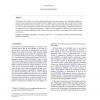Free Online Productivity Tools
i2Speak
i2Symbol
i2OCR
iTex2Img
iWeb2Print
iWeb2Shot
i2Type
iPdf2Split
iPdf2Merge
i2Bopomofo
i2Arabic
i2Style
i2Image
i2PDF
iLatex2Rtf
Sci2ools
CGF
2005
2005
N-Buffers for efficient depth map query
We introduce the N-buffer as a tool for multiresolution depth map representation. This neighborhood buffer encodes the value and position of local depth extrema at different scales in an image cube, in contrast to the image pyramid. The resulting increase in storage space is largely compensated by the following benefits: objects of any size can be culled in constant time against an occlusion map using four depth lookups; visibility-like queries can be performed in vertex and fragment programs; N-buffers can be computed very efficiently with graphics hardware. We present three applications of this datastructure, and in particular a novel approach for shadow volume acceleration. Categories and Subject Descriptors (according to ACM CCS): I.3.7 [Computer Graphics]: Three-Dimensional Graphics and Realism
| Added | 15 Dec 2010 |
| Updated | 15 Dec 2010 |
| Type | Journal |
| Year | 2005 |
| Where | CGF |
| Authors | Xavier Décoret |
Comments (0)

